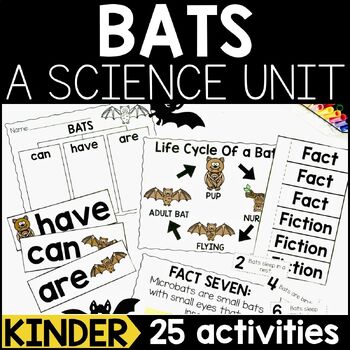Bats: All About Bats: Bat Craft & Activities for Kindergarten | Bat Science Unit
- Zip
What educators are saying
Also included in
- Engage your class in exciting, hands-on learning as you teach them all about holiday animals! These units are perfect for science in Kindergarten, First Grade, and Second Grade classrooms. With this bundle you'll get 7 week-long units to teach during the holidays. Your students will love the interacPrice $36.00Original Price $59.00Save $23.00
- Delve into the fascinating world of animals with our expanding Animal Study MEGA BUNDLE. Each weeklong unit features captivating PowerPoint lessons, engaging student activities, and paired worksheets. Perfect for year-round use, these resources offer endless learning adventures! Don't miss out—purchPrice $79.00Original Price $180.00Save $101.00
- Engage your class in exciting hands-on learning experiences all year long with this Kindergarten Science Bundle. This kindergarten science curriculum resource contains 52 week-long science units and 12 months worth of seasonal/holiday science experiments. This bundle is packed with activities and inPrice $120.00Original Price $624.39Save $504.39
Description
Learning all about bats is so much fun! This exciting bat unit is a great resource to engage your learners during spooky season or when studying nocturnal animals. This weeklong science unit is filled with exciting hands-on learning experiences and student activity pages. Your students will love completing the Bat Craft within this unit! These activities are great fit for Kindergarten, First Grade, and Second Grade classrooms.
Your students will learn all about bats, their life cycle, their characteristics, and countless facts to share with their friends and family.
With this unit you’ll have everything you need and more to teach your students all about bats. Click on “View Preview” to get a better idea of what you’ll get!
THIS BAT UNIT IS INCLUDED IN OUR:
WHAT'S INCLUDED IN THIS UNIT:
- Unit Overview
Lesson Plans - At-Home Letter
- Teacher Guide
Science Center & Stem Ideas - Science Questions
- Book, Video, and Song Lists
Bat Facts Posters and PowerPoint - Bat Facts Emergent Reader
- Question of the Week
- Bats Can-Have-Are Activity
- Parts of a Bat Posters and Worksheets
- Life Cycle of a Bat Posters and Worksheet
- Bat Fact or Fiction
- Bat Facts or Animal Research Craft
BONUS MATERIALS
- Writing Center
- Definition Posters
- Word Wall
- Circle Maps
- Bats Bingo
- Fingerplay
- Flying Bat STEM
- Bat Craft
- Positional Words Emergent Reader
- Bat Life Cycle Hat
- Bats vs. Birds Posters and PowerPoint
- Bats vs. Birds Worksheets
- Nocturnal or Diurnal Sort
- Nocturnal or Diurnal Worksheet
WAYS TO USE THIS UNIT
- Use the Bat Facts PowerPoint to open your daily mini-lesson. Gather your students for a quick, whole group lesson to kick off each day of learning. The slideshow includes 11 interesting spider facts sure to excite your students. There is also a Bats vs. Birds PowerPoint that is great to use for comparing and contrasting.
- Students will love completing their research craft. Try incorporating the this or other crafts from this unit in a science center. Your students will have so much fun collaborating with their friends while learning all about bats.
- This unit is filled with student activity pages. Use the many printables and emergent readers for independent work or partner practice. Not enough time during your science block? We get that! Create cross curricular connections when you incorporate these nonfiction learning materials in your reading and writing block.
- Provide closure to each day's learning by using the songs and videos that are linked in this product. You won’t ever have to go searching for fun ways to engage your students when you purchase this product!
WHAT TEACHERS ARE SAYING:
⭐⭐⭐⭐⭐ "This pack had amazing activities with an option for both real art and clipart. The prep was a breeze and most of the activities were already adapted to different age levels and abilities making it great in the classroom!"
⭐⭐⭐⭐⭐ "This resource was EVERYTHING I was looking for. It included more than enough resources I needed for a 5 day mini unit. I liked that it included many different types of worksheets that correspond with the topics included. As a first year teacher, this will be a resource that will prove to be useful year after year!!"
⭐⭐⭐⭐⭐ "I love every animal unit I have gotten! I love the detailed slides that help me seem like an expert in the animal. I also love the writing/fact book to make. My students really enjoyed learning about bats."
CHECK OUT THESE RELATED PRODUCTS:
LET’S CONNECT
➡️Subscribe to our weekly newsletter where you'll receive freebies and be the first to know about sales and new products.
If you have any questions or need help, please email us at hello@adabofgluewilldo.com.
Copyright © A Dab of Glue Will Do, LLC








